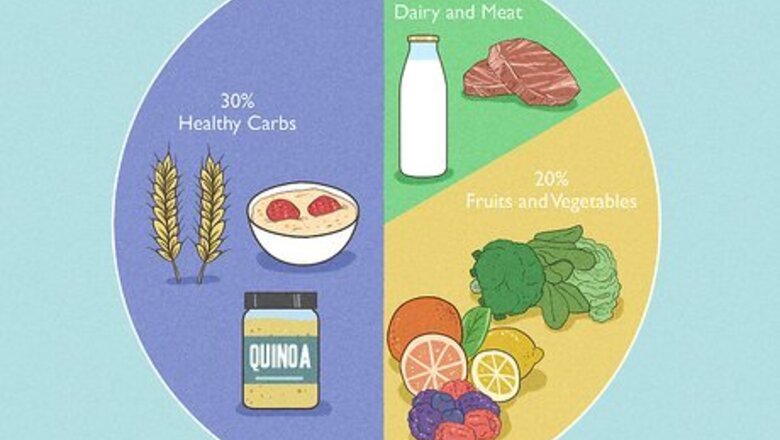
views
Creating Healthy Eating Habits
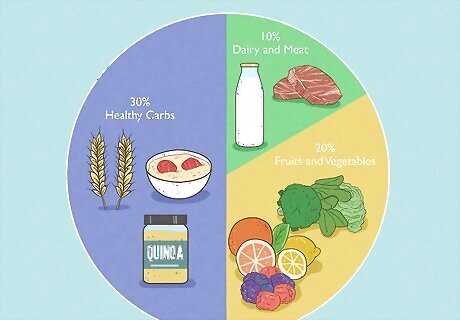
Eat a balanced diet. Eating a balanced diet is important for making sure your body gets all of the nutrients in the right amounts to keep you feeling satisfied while eating less. At each meal, fill ½ of your plate with fruits and veggies, ¼ of your plate with whole grains, and ¼ of your plate with lean proteins. You can also have healthy plant oils in moderation. Healthy carbs include rye, quinoa, oatmeal, brown rice, and other nutrient-rich grains. Choose fruits and vegetables that are rich in nutrients and low in sugars, such as citrus fruits, kale, arugula, and spinach.
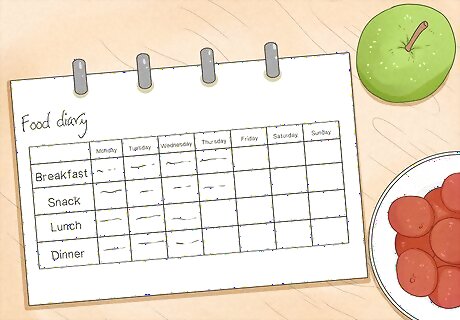
Keep track of everything that you eat. Many people don’t realize how much they eat or how often they’re eating during the day. Keeping a food diary for a few days can help you realize what parts of your diet need adjusting. Some people also choose to keep track of how they’re feeling and what they’re doing when they eat to notice patterns in emotional eating. Additionally, you should keep track of how long it takes you to eat each meal or snack. Eating slowly can help you feel full quickly.
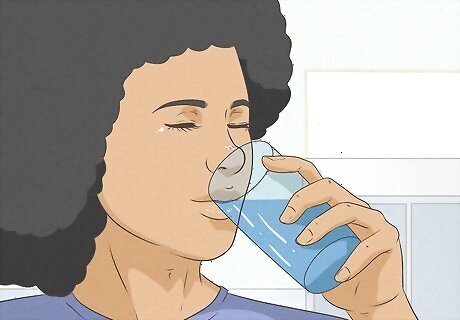
Drink plenty of water between meals. Water can help you feel full between meals and curb cravings without expanding your stomach like food would. You can also get water from vegetables like cucumbers, broccoli, and carrots, and fruits such as watermelon, plums, and apples. Alternatively, if you don’t like the taste of water alone, you can drink tea or flavored water. Drinking enough water can also help prevent water retention, which can make your stomach appear larger.
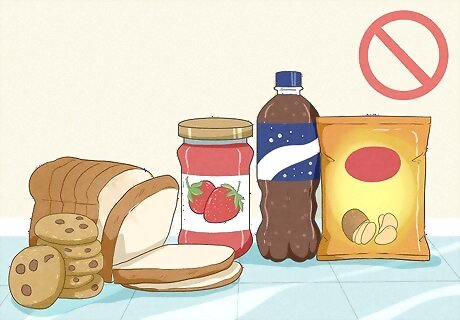
Eat fewer unhealthy fats and empty calories. Check the label on the back of the packaging for saturated and trans fats, which are unhealthy and can cause you to gain weight. Empty calories include almost no nutrients and they should also be avoided. Examples of empty calories include white bread, chips, cookies, jam, fruit juices, soda, and most sugary breakfast cereals. Foods high in saturated fats include baked goods, fried foods, fatty cuts of beef, lard, cream, butter, cheese, and dairy products made with whole or 2% milk.
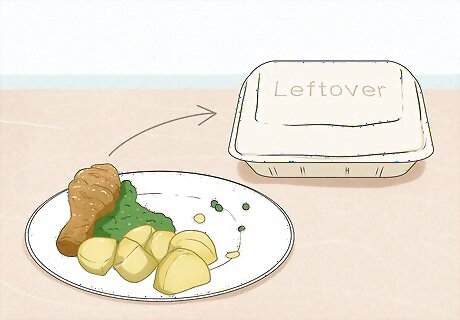
Practice portion control when preparing and eating meals. At home, you can make sure you’re not overeating by placing leftover food in the refrigerator after putting a serving on your plate. You can take control of your portions while eating out by splitting an entree with someone, or only eating half of what is served on the plate and taking the rest home. Store tempting foods out of the way so that you’re not able to access them easily. When you reduce your food intake by eating smaller portions, your body will eventually get used to eating less food.
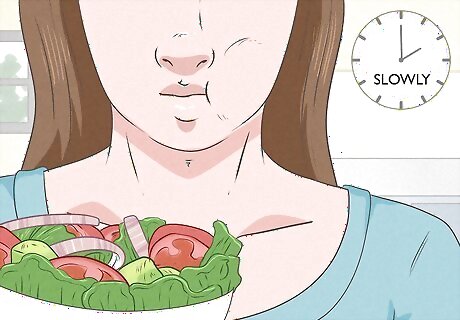
Eat slowly and only until you start to feel full. Many people overeat because they don’t know when they feel full, causing their stomachs to expand temporarily to accommodate the food before digesting it. Take your time when you eat, chew each bite thoroughly, and drink water between bites. Your body will signal your brain when you’ve eaten enough. Pay attention to your body’s signals so that you don’t eat too much food. If you want food, ask yourself if you’re really hungry or just craving more of the food’s taste or texture. The average person’s stomach capacity without any food in it is 200 mL, but when it comes time to eat, some people’s stomachs can relax to accommodate 1 liter of food or more.
Committing to an Exercise Routine
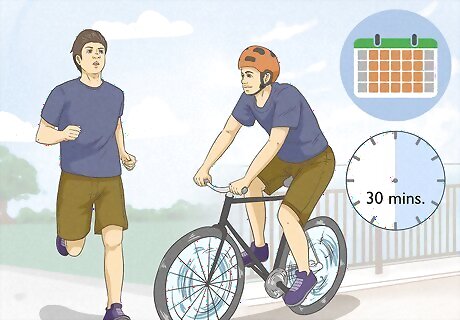
Practice aerobic exercise 75-150 minutes per week. Aerobic exercise is great for burning calories and helping you lose weight because it raises your heart rate. Running, swimming, hiking, biking, and dancing are all forms of aerobic exercise that engage your body to help with all-over weight loss. Aerobic exercise helps to complement the work that you’ve done by maintaining a healthy diet and makes your body utilize the energy that you’re getting from your food, rather than storing it as fat. To start out with aerobic exercise you can run, jog, or even just walk to raise your heart rate and get your body moving. After your stamina is stronger, you can move on to more high-impact activities.
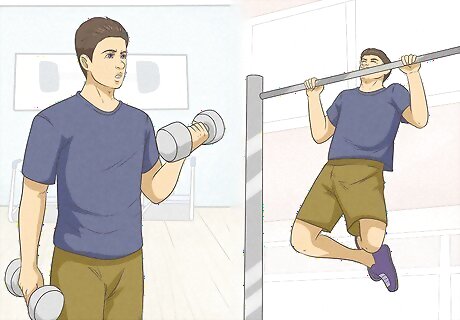
Do weight training twice per week. In addition to aerobic exercise, do resistance or strength training regularly. Not only will this help you burn calories, it can tighten your core muscles. Training with weights increases your balance, stamina, and flexibility while also helping to build muscle and burn fat. Exercises like crunches, planks, and pull-ups engage your core stomach muscles and help to build strength in this area, which can result in a more toned look. Exercising your core won’t specifically help you lose belly fat, since you can’t target weight loss to one particular part of your body. However, it can help you lose weight all over and tone the muscles in your belly so they look more defined.

Rotate the types of activities that you do. Commit to doing aerobic and weight training exercises throughout the week, rotating between the 2 types of activities each day. This will provide your body with some rest in between activities and allow you to focus on specific areas of your body on different days. Alternating workouts can also prevent your body from adapting to different exercises, allowing you to get the full benefits of each exercise.
Avoiding Common Mistakes
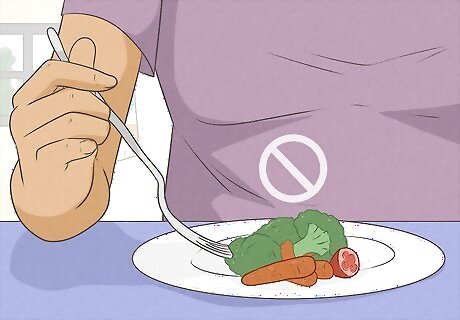
Resist the temptation to “crash” diet. Extremely restrictive diets that don’t allow for the consumption of specific food groups are unsustainable. Although these diets might cause your stomach to look and feel smaller initially, the results won’t last due to constant hunger and your body not getting the nutrients that it needs. Plus, crash diets can actually damage your body, including your heart. Restrictive diets can cause you to “binge” once the diet is over, which can make you feel sick by filling your stomach past its normal capacity in one sitting.
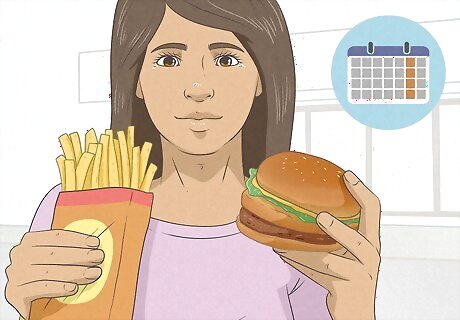
Allow yourself an occasional indulgence. Much like crash diets, a healthy diet can become unhealthy when you begin to restrict yourself from all sugars, fats, and “bad” foods. You might find it helpful to allow yourself to indulge in comfort foods or treats on occasion. Remember to always practice portion control to not gorge yourself or make yourself feel sick.
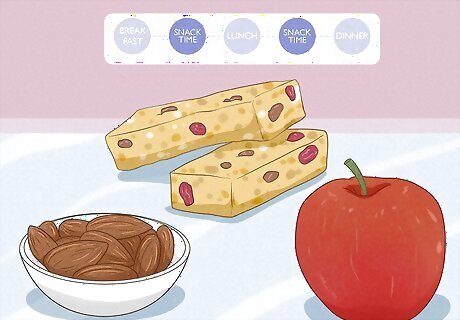
Eat small snacks throughout the day to curb cravings. Many people restrict themselves to only 3 meals per day and are left feeling hungry. Having a healthy snack like nuts, a granola bar, or a piece of fruit can keep you satisfied between meals and help to avoid overeating. Eating several snacks or small meals throughout the day whenever you feel hungry can also help retrain your brain and stomach and make you more aware of your body’s hunger and satiation signals.


















Comments
0 comment